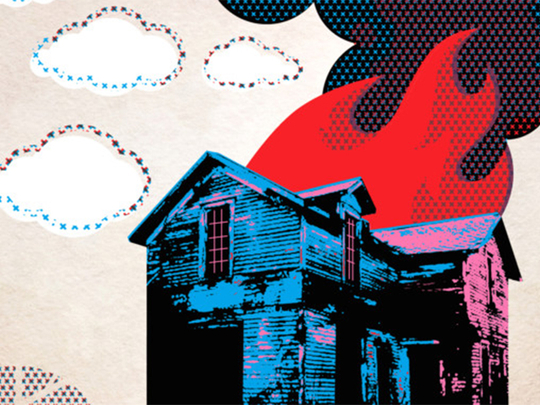
Little Fires Everywhere
By Celeste Ng, Penguin Press, 352 pages, $24
Is it possible to plan a community; to construct it from scratch, instil it with virtues and benefits, and order it to your satisfaction? The founders of Shaker Heights, Ohio , certainly thought so: in 1905, railroad magnates the Van Sweringen brothers picked a wide place in the road and set about developing one of the United States’s first garden cities. Their intention was to create a suburban retreat, connected to the industrial powerhouse of nearby Cleveland but insulated from its fug and bustle: a place built on notions of harmony and cooperation, with rules regulating every aspect of communal life, down to the colours you could paint your house (“slate blue, moss green, or a certain shade of tan”) and how high (“six inches”) your lawn was permitted to grow.
It was — is — a miniaturised version of its motherland: the United States of America, that shining city on the hill; a country that conjured itself into being on the strength of an idea. The citizens of Shaker Heights, in which Celeste Ng’s novel is set, possess a heightened sense of the superiority enjoyed by all their compatriots thanks to the purity of their founding principles. “When the troubles of the outside world made their presence felt in Shaker Heights,” we hear, “the community felt obliged to show this was not the Shaker way.”
Others may scrap and brawl, but in Shaker Heights the community is “unified and beautiful”: the weeds are pulled, the cookies are baked (“with all proceeds benefiting charities”), and the school band goes marching on, and on.
It’s a soothing vision. But visions, as the citizens of the US are currently discovering, only remain shared while everyone is looking in the same direction — and seeing the same thing. Ng’s second novel revisits many of the themes explored in her acclaimed debut, Everything I Never Told You: race, family, the questionable benefits of fitting in and the everyday tragedy of children outgrowing their parents. Now we have the added dimension of this perfectly planed and polished backdrop, throwing the knottiness of the narrative into sharp relief.
The novel opens not with a little fire, but a grand conflagration: in the first scene we see Mrs Richardson, wife, mother, pillar of the community and lifelong resident of Shaker Heights, standing “on the tree lawn clutching the neck of her pale-blue robe” and watching her house burn down. Her youngest daughter, mulish, Doc Marten-sporting Izzy, is the chief suspect, but it soon becomes clear that the inferno has, as the firefighters put it, “multiple points of origin”.
One spark can be traced back to the moment, 11 months earlier, when itinerant artist Mia Warren blew into town with her teenage daughter, Pearl, and moved into the Richardsons’ rental apartment. Another ignited in the custody battle raging around a baby girl adopted by a childless white couple after being left outside a fire station by her Chinese immigrant mother; an anguished tug-of-war that roils and rattles the usually serene Shaker community.
Yet a third is kindled out of the tensions that criss-cross the group of five teenagers — the four Richardson siblings and Pearl whom, with a range of competing motivations, they collectively coopt — around which the story circles. For these adolescents, typical feelings of constraint and stultification are amplified by their hometown’s edgeless, inoffensive exterior. Individually, these sparks might have flared and faded; collectively, they ignite.
Ng herself lived in Shaker Heights in the late 1990s, when Little Fires Everywhere is set. Her feeling for the place and the period — the pre-9/11, pre-digital, pre-global financial crisis era that, in the intervening years, has acquired a prelapsarian patina — lends depth and texture to her descriptions, while also allowing her to construct a narrative voice that revels in its ironic distance. She manages the impressive feat of allowing us simultaneously to sink into the world she creates and boggle at its naivety and self-satisfaction (“I mean, we’re lucky,” says Lexie Richardson, complacently watching Jerry Springer, “no one sees race here”). At the same time, the pace and structure of the story keep us turning the pages, eager to find out why the fires were set, who will get custody of the baby, what secrets are buried in Mia’s past and whether their uncovering will lead to catastrophe.
This is a novel that convinces and compels; it’s a pleasure to read. If there’s a criticism to be made, it’s the same criticism Ng herself implicitly makes of Shaker Heights: that planning to excess can result in something that feels, finally, phony. The plot hinges on a series of coincidences that don’t stand up to scrutiny: they are too neat and too many, and create the impression, in the end, that for all the authenticity of its setting, the story is not quite like life; it’s too clever, too complete, to be entirely plausible.
The story is not quite like life; it’s too clever, too complete, to be entirely plausible
“Winslow Road was one long line of duplexes,” the narrator explains, of the cheap street where Mia and Pearl live, “but standing on the curb you would not have known it. From the outside you saw only one front door, one front-door light, one mailbox, one house number ... They had been designed that way on purpose. It allowed residents to avoid the stigma of living in a duplex house — of renting instead of owning — and allowed the city planners to preserve the appearance of the street, as everyone knew neighbourhoods with rentals were less desirable.” The facade may be an illusion — but it’s a seductive one. Suspend your disbelief for a while, and enjoy it.
–Guardian News & Media Ltd









